
Authentic Indonesian Food to Try in Indonesia Now
 December 24
December 24
 34 min read
34 min read
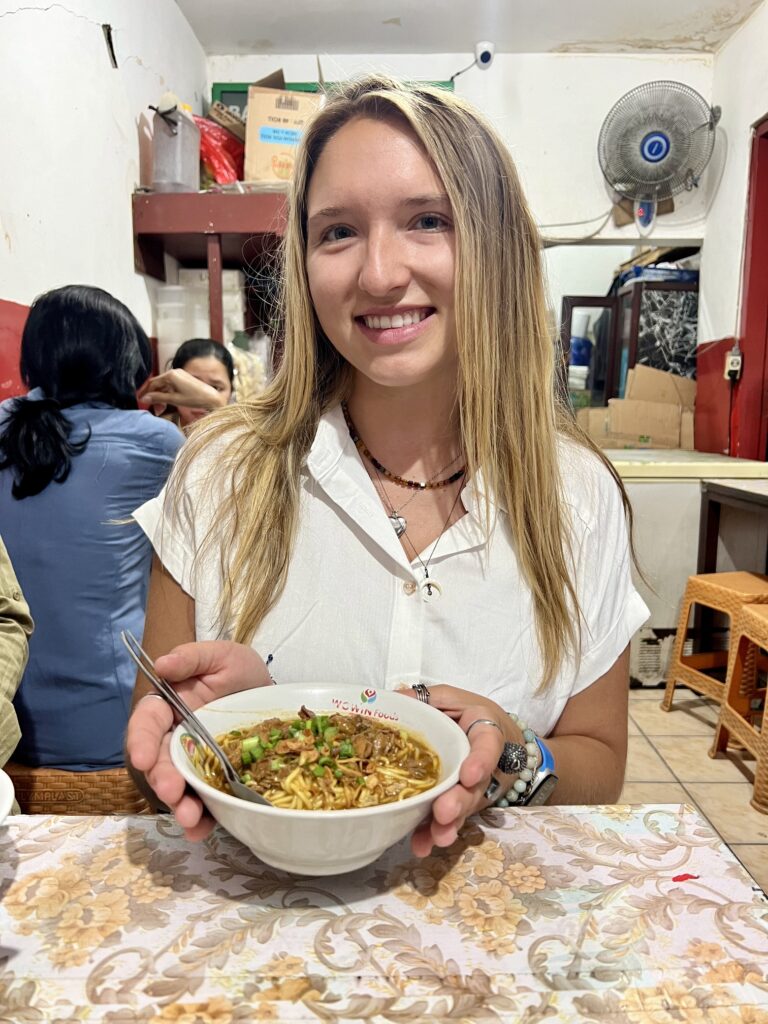
Authentic Indonesian Food-Key Highlights
- Authentic Indonesian food is a vibrant adventure for your taste buds, celebrated for its bold flavors, aromatic spices, and fresh ingredients.
- From the iconic Nasi Goreng to the fiery Rendang, Indonesian dishes offer something for every palate, whether you crave spicy, savory, or sweet.
- Explore the world of street food delights, from bustling Warung Kaki Lima to tempting food stalls offering local favorites like Sate Ayam and Martabak.
- Discover the regional specialties across the Indonesian archipelago, each island boasting a unique culinary identity influenced by history, culture, and local produce.
- Whether you’re a seasoned foodie or a curious traveler, Indonesian cuisine promises an unforgettable culinary journey.
Introduction
Indonesian cuisine is an exciting mix of flavors and smells. It shows off the rich cultures across the islands. You can find popular dishes like Nasi Goreng, which is loved and easy to get at street food stalls all over Indonesia. There are also tasty curries and savory satays. Each dish combines fresh ingredients with special herbs and spices, contributing to the vibrant creative economy. So, whether you are trying street food or enjoying a fancy meal, get ready for a food adventure that offers great experiences and keeps you wanting more. Explore my list below of my favorite authentic Indonesian food below!
Top Indonesian Cuisines You Must Try
Indonesian cuisine is much more than just eating. It brings you into a world full of history, culture, and flavor. The food has many influences from trade and uses local ingredients. You can taste everything from mild and tasty dishes to spicy and rich ones.
When you explore Indonesian food, you can start at busy street food stalls. Here, you will smell the delicious scent of Sate Ayam cooking on charcoal. You can also eat at traditional restaurants that offer Nasi Padang, filled with many colorful side dishes. No matter where you go in Indonesia, each area has its own special food traditions. These meals show off the rich resources and the cooking skills of the people there.
1. Nasi Goreng (Indonesian Fried Rice)
Nasi Goreng, considered Indonesia’s national dish, is a famous dish that many people love. It has a great mix of flavors that show off the country’s diverse food culture. This dish has fragrant rice that is fried with ingredients like shallots, garlic, sweet soy sauce (kecap manis), and chili sauce for a slight kick. It often comes with crispy shallots, pickled vegetables, and a fried egg on top. Nasi Goreng is a perfect example of Indonesian cooking, similar to Nasi Lemak, in a single and delicious plate. Enjoy this classic street food favorite for its rich history and strong flavors.
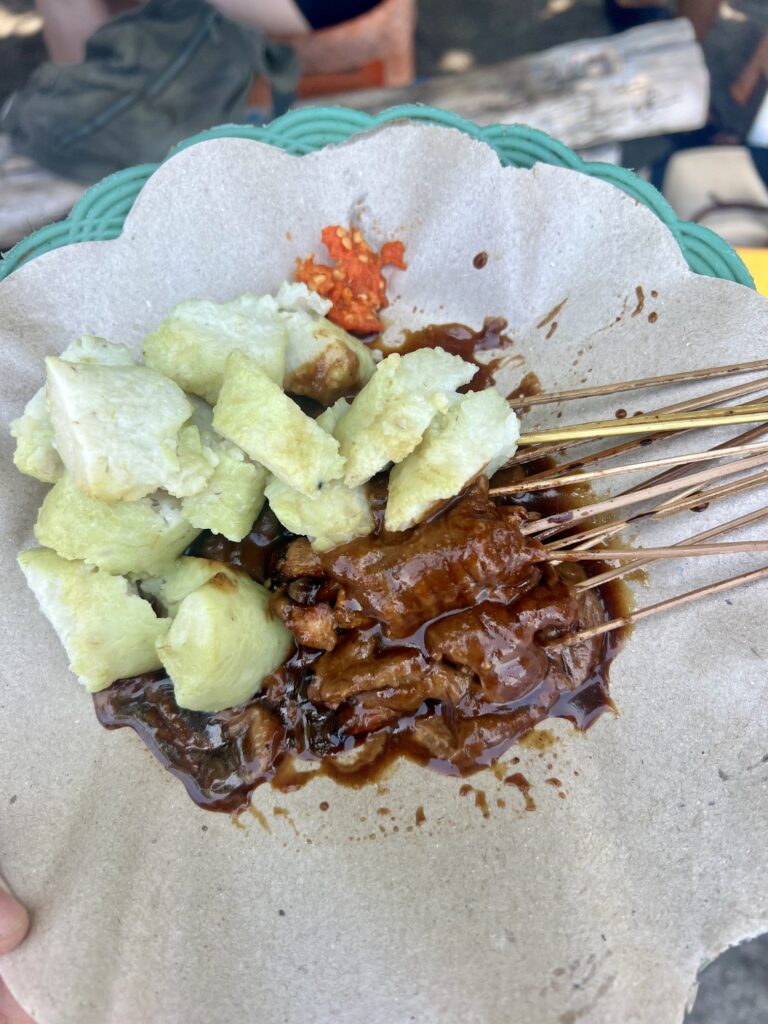
2. Sate Ayam (Chicken Satay)
Sate ayam, also known as chicken satay, is a popular street food from Indonesia, alongside Sate Padang. This dish features marinated chicken pieces that are skewered and grilled perfectly, and it can be made with various types of meat as well. It is covered in a tasty peanut sauce. Each bite offers a mix of flavors, including the sweetness of coconut milk and the savory taste of soy sauce. It usually comes with rice cake or cucumber slices on the side. Sate ayam captures the true spirit of Indonesian cuisine. This dish is a must-try for anyone wanting to enjoy the delicious food of Indonesia.
3. Rendang (Spicy Meat Dish)
Rendang is a famous dish from Indonesia. It is a spicy meat dish cooked slowly in coconut milk and many spices. This dish comes from Padang. The meat becomes very tender while soaking in a rich sauce. Nutmeg, cinnamon, and turmeric add a special taste that makes it delicious. People love rendang because of its great flavor and soft texture. It is often served at celebrations and special events. Rendang shows the skill of Indonesian cuisine. With its strong and unique taste, it is something every food lover should try.
4. Gado-Gado (Vegetable Salad with Peanut Sauce)
Gado-gado is a tasty Indonesian dish. It is a colorful salad made with fresh vegetables. The dish is covered in a rich peanut sauce, which makes it very flavorful. You will often find ingredients like beansprouts, cabbage, and spinach in it. Boiled eggs, tofu, and tempeh add protein to the mix. The peanut sauce includes coconut milk and palm sugar, giving it a creamy and nutty taste. Gado-gado has a great mix of textures and flavors. Many vegetarians and food lovers enjoy it while exploring Indonesian cuisine.
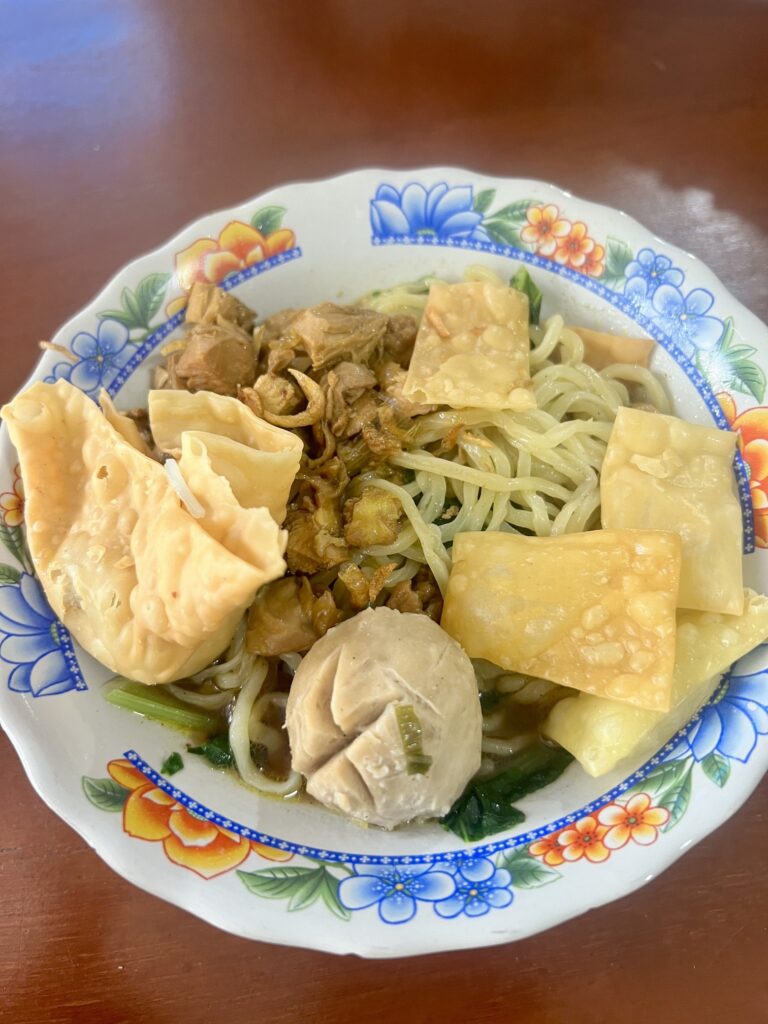
5. Bakso (Meatball Soup)
Savor the tasty Indonesian comfort food called bakso. It is a meatball soup you often find at busy street stalls and local places. This filling dish has juicy meatballs. They are usually made from ground meat and tapioca flour. The meatballs float in a rich broth that smells great because of spices like garlic, shallots, and ginger. It is served hot with a mix of sides. You get fresh vegetables, noodles, and a sprinkle of savory soy sauce. Bakso shows the creative and warm spirit of Indonesian cooking. Enjoy a steaming bowl for a real taste of Indonesia’s food heritage.
6. Nasi Padang (Padang Rice)
Nasi Padang, also called Padang Rice, is a tasty dish from Indonesia. It comes from the Padang region. This dish includes steamed rice, soybean cake, and many delicious side dishes, much like Nasi Campur. Some popular options are rendang (spicy meat), sambal (chili paste), curries, and different vegetables. This meal is shared, giving people a chance to enjoy a range of bold and rich flavors. Nasi Padang is loved for its aromatic spices, dishes made with coconut milk, and the mix of textures. It is a must-try if you want to explore Indonesian cuisine.
7. Babi Guling (Balinese Roast Pork)
Savor the unique tastes of Balinese food with babi guling. This dish is a must-try for anyone who loves pork. It features juicy roast pork that is seasoned with fragrant spices and roasted just right. This cooking method gives the pork a crispy skin, adding a nice crunch to each bite.
Babi guling is tied to the rich culture of Bali and is commonly served at special events and ceremonies. The mix of flavors and textures in this dish shows the cooking skill of the Balinese people. It offers a real delight for anyone who enjoys good food.
8. Ayam Betutu (Balinese Roasted Chicken)
Ayam Betutu is a delicious dish from Bali that you must taste. This traditional roasted chicken is soaked in a mix of tasty spices. These spices include galangal, turmeric, and ginger. The chicken is then wrapped in banana leaves, which adds a great smell. It is cooked slowly, making the meat very juicy and full of flavor. Ayam Betutu shows the skills of Balinese cooking, similar to other dishes found on the island of Lombok. Enjoy the rich food culture of Bali by trying this special dish on your journey through Indonesia.
9. Pempek (Sumatran Fish Cakes)
Pempek is a traditional fish cake from South Sumatra, Indonesia. You have to try it when you visit. These tasty snacks are made with fish and tapioca. They get flavor from spices like garlic and salt. The mix is shaped into balls or rolls and then boiled or fried. Pempek is usually served with a sweet and sour sauce called cuka. This dish has a great mix of flavors and feels. It shows off the rich food culture of Indonesia. Make sure not to miss these yummy fish cakes while exploring this lively Southeast Asian country.
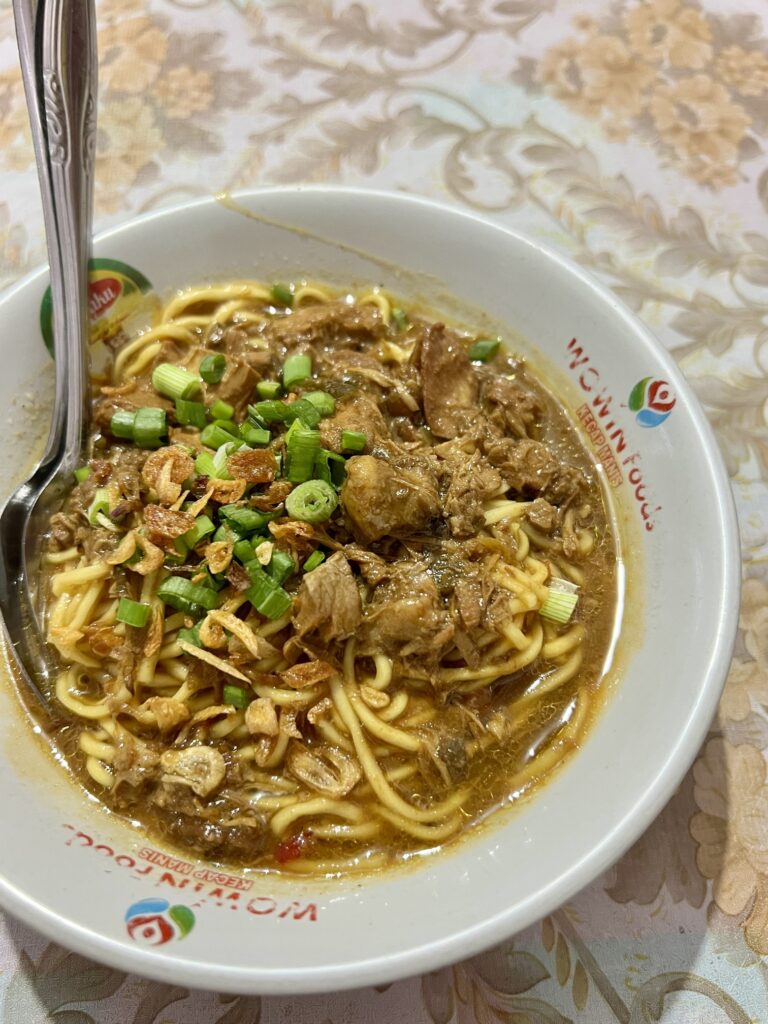
10. Mie Goreng (Fried Noodles)
Mie goreng is a popular dish from Indonesia. People love it for its tasty mix of spices and textures. This stir-fried noodle meal usually has soy sauce, shrimp paste, bean sprouts, and sometimes seafood or chicken. As a favorite street food, mie goreng shows the different cooking styles in Indonesian cuisine, and it can even be made with Indomie instant noodles for convenience. The noodles soak up the savory sauces. This creates a wonderful umami flavor that is hard to resist. For a real taste of Indonesia, you should try a plate of mie goreng. It’s a fun and tasty culinary experience.
11. Ikan Bakar (Grilled Fish)
Ikan Bakar is a tasty Indonesian dish that features grilled fish. The fish is marinated in a mix of soy sauce, lime juice, and coconut oil. It is then grilled to perfection over an open flame. This dish shows Indonesia’s cooking skills and uses fresh ingredients.
Ikan bakar is often served with fragrant rice and crunchy vegetables. It highlights the colorful and varied flavors of Indonesian cuisine. Seafood lovers and food lovers should not miss this dish. Enjoy the great taste of grilled fish in Indonesia!
12. Tumpeng (Cone-Shaped Rice Dish)
Tumpeng is a cone-shaped rice dish. It is often served during special events to show gratitude and blessings. This traditional food from Indonesia features rice that is flavored with turmeric. It is surrounded by many tasty side dishes. The cone shape stands for harmony and balance in Indonesian culture. This makes Tumpeng a beautiful centerpiece at celebrations. It is not just food; it is a symbol of togetherness and gratitude for life’s blessings. Indonesian food to try in Indonesia offers many flavors and meanings, but Tumpeng is a major symbol of unity.
13. Martabak (Stuffed Pancake or Pan-fried Bread)
Martabak is a tasty Indonesian snack that mixes many flavors. It looks like a stuffed pancake or fried bread. The dish is made with rich ingredients like peanuts, chocolate, cheese, and condensed milk. These create a nice mix of sweet and savory tastes. The outer layer is crispy, while the inside is gooey. Every bite brings a fun surprise. Martabak is a special experience that shows the creativity found in traditional Indonesian cuisine. Be sure to try this amazing dish when you explore the many flavors of Indonesia.
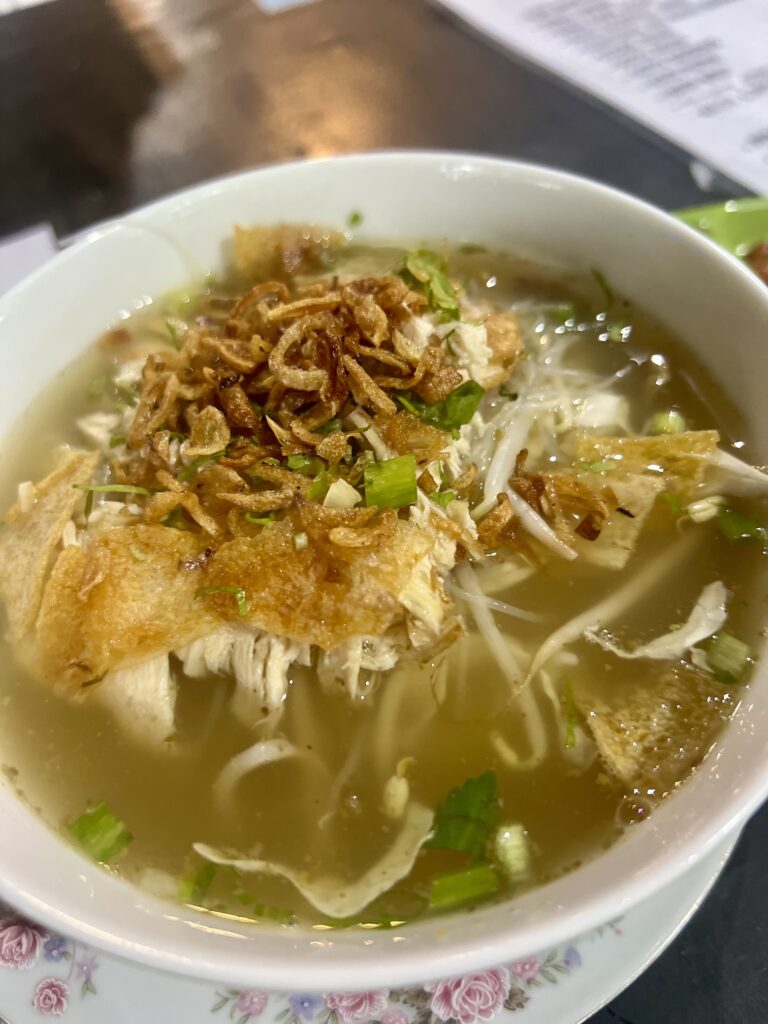
14. Rawon (Black Soup)
Rawon is a tasty traditional dish from Indonesia. It comes from East Java and is known for its black soup. The dark color comes from the keluak nut, which adds a deep and rich flavor. The main ingredient is beef, which is cooked slowly with various herbs and spices to make a hearty broth. You usually eat rawon with rice and sambal on the side. This dish lets you experience Indonesia’s rich food culture. It brings together different tastes, showing off what Indonesian cooking is all about.
15. Soto Ayam (Chicken and Rice Soup)
Soto Ayam is a popular Indonesian dish. It is a tasty chicken soup and rice soup. This soup is filled with good herbs and spices. These include lemongrass, turmeric, and galangal. The broth is rich and full of flavor. It is cooked with coconut milk, making it comforting and warm. Soto Ayam comes with shredded chicken, vermicelli noodles, and hard-boiled eggs. There are also crispy fried shallots on top. This dish shows what comfort food means in Indonesia. To make it even better, fresh lime juice and sambal add a nice mix of tanginess and heat. Soto Ayam is truly a treasure of Indonesia’s food culture.
16. Nasi Pecil (Rice and Fried Egg in Peanut Sauce)
Nasi pecil is a tasty dish from Indonesia. It combines fragrant rice with a crispy fried egg that is covered in rich peanut sauce. The peanut sauce adds a creamy texture. This dish offers a satisfying meal. Nasi pecil shows the variety in Indonesian cuisine. It shows how simple ingredients can make bold flavors. Many locals and visitors love this dish. It gives you a real taste of Indonesian food.
Essential Ingredients in Indonesian Cooking
Indonesian cuisine is full of exciting flavors. It mixes aromatic spices, fresh herbs, and bright ingredients. From the spicy chilies to creamy coconut milk, every ingredient is important for the special tastes of Indonesia.
The key to Indonesian cooking is its spice pastes, known as “bumbu.” These flavorful mixes usually include shallots, garlic, ginger, turmeric, and chilies. They create the base for many Indonesian dishes, adding rich layers of flavor. Coconut milk is also a main ingredient. It gives a smooth texture and a hint of sweetness.
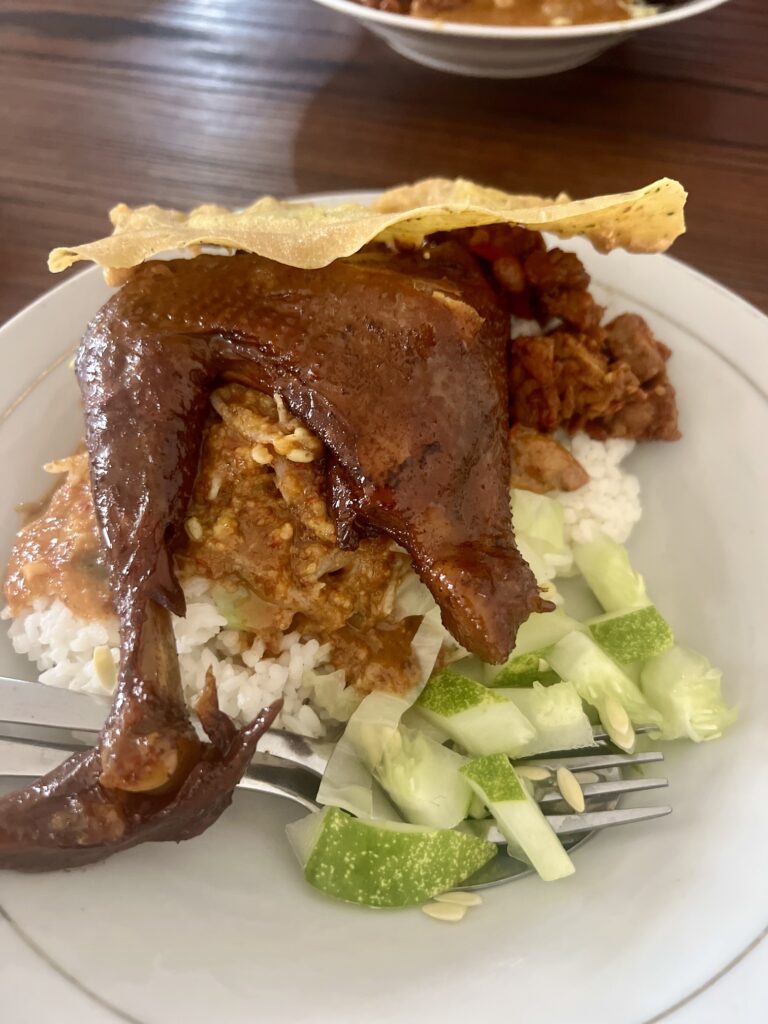
Coconut Milk and Its Versatility
Coconut milk is an important part of Indonesian cuisine. It shows how rich and flexible Indonesian flavors can be. This milk comes from grating the flesh of mature coconuts. It gives a creamy texture, a hint of sweetness, and a unique smell to many Indonesian dishes.
In dishes like Beef Rendang, or in creamy curries and strong soups, coconut milk mixes well with bold Indonesian spices. This makes a nice and balanced taste. Its richness helps to reduce the heat from chilies, and its sweet flavor goes well with the savory aspects of Indonesian cooking.
Coconut milk isn’t just used in main dishes; it’s also great in Indonesian sweets and drinks. You can find it in creamy coconut ice creams and refreshing coconut-flavored drinks. Coconut milk truly adds a bit of tropical delight to them.
The Variety of Sambals (Spicy Chili Pastes)
Indonesia has a wide range of sambals that provide a spicy and tasty experience. These chili pastes come in different types, each with its own ingredients and level of spiciness. You can enjoy the classic sambal oelek, which uses red chili peppers. Another option is the tangy sambal matah, mixed with shallots and lemongrass. Don’t forget to try sambal terasi, which includes shrimp paste, or the colorful sambal bajak that has a blend of spices. Embrace the variety of sambals; they are a key part of Indonesian food. Each dollop offers a burst of flavor.
Tofu and Tempeh: The Vegetarian Delights
Indonesian cuisine is famous for its strong flavors and many meat dishes. However, it also has many tasty vegetarian options. Tofu and tempeh are two important ingredients in Indonesian vegetarian cooking. They both come from soybeans and bring texture, protein, and variety to the meals.
Tofu is made from soybean curd. It has a mild flavor and can soak up the taste of other ingredients. You can find tofu in Indonesian vegetarian dishes through frying, stir-frying, or in soups and curries. It fits right in.
Tempeh is made from fermented soybeans. It has a firmer texture and a slight nutty taste. It can be sliced, diced, or crumbled, giving a nice bite. Together, tofu and tempeh add plant-based protein and serve as a nice base for Indonesian flavors.
Exotic Spices That Define Indonesian Flavors
The charm of Indonesian flavors comes from its unique use of exotic spices. This wonderful mix of scents has been making people happy for centuries. Indonesia sits where old spice routes met, giving it a rich history filled with different smells and tastes.
The spicy warmth of cinnamon and nutmeg mixes with the fresh zest of lemongrass and kaffir lime leaves. These Indonesian spices awaken the senses and take you right to Southeast Asia. Turmeric, with its strong smell and bright yellow color, is key in Indonesian cooking. It adds color and richness to dishes.
These spices often blend into fragrant pastes and create the base for many Indonesian meals, turning simple foods into amazing dishes. Each spice is important, bringing flavor, scent, and a little magic to Indonesian cuisine.
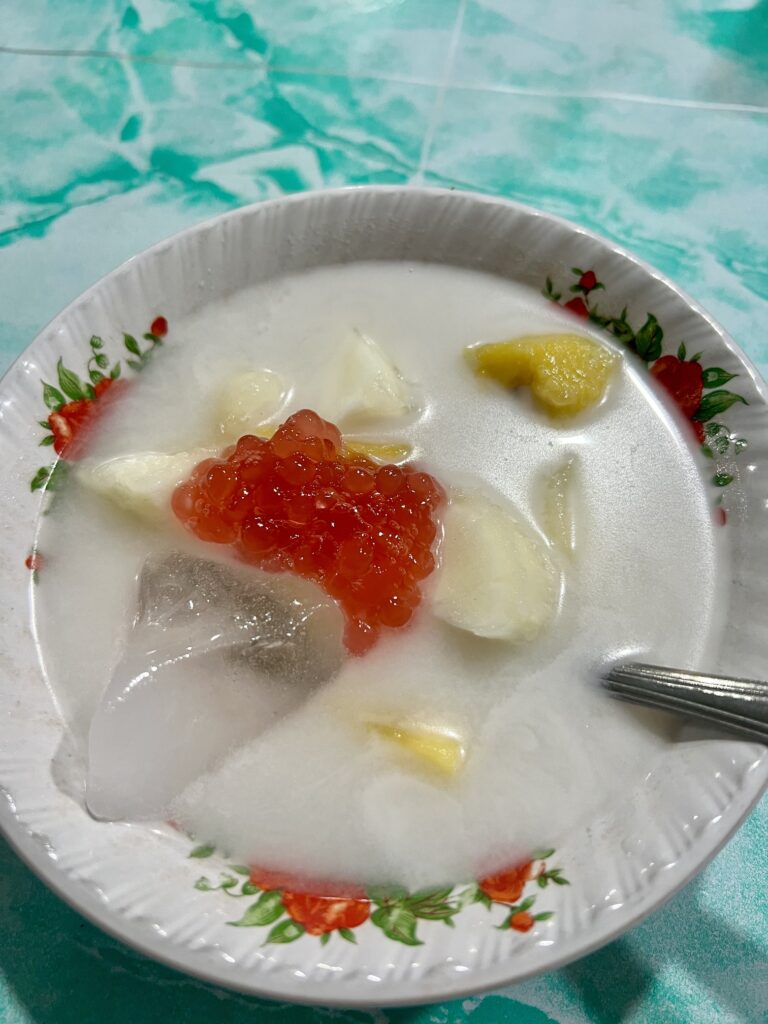
The Art of Indonesian Street Food
Stepping into the lively world of Indonesian street food is an exciting experience. You walk through busy markets and smell delicious dishes that showcase Indonesian culture. It’s more than just something quick to eat; it is a part of everyday life and is deeply woven into Indonesian society.
You can smell the smoky scent of sate grilling on charcoal. You will also see many colorful snacks in glass cases. Indonesian street food pleases both your eyes and your stomach. Talk to the friendly vendors, enjoy the tempting smells, and explore the many flavors of Indonesian food, one tasty bite at a time.
Warung Kaki Lima: The Essence of Indonesian Street Dining
Warung Kaki Lima is the heart of Indonesian street food. These small food stalls show the culture and warmth of Indonesia. They usually set up on sidewalks or street corners and give a taste of Indonesian cuisine.
Named for their five-foot-wide size, Warung Kaki Lima are more than just places to eat. They are spots where people gather and connect. Locals and visitors come together over hot bowls of noodles, fragrant rice plates, and tasty satays.
Indonesian vendors greet you with smiles and a warm welcome. They cook meals with love and care, which is more than just feeding people. It is a shared experience that shows the true spirit of Indonesian hospitality.
Must-Try Street Foods: From Satay to Martabak
As you walk through the busy streets of Indonesia, you will smell a mix of flavors from the food stalls. The street food ranges from savory to sweet, spicy to tangy. There is something for everyone. Here are some street food delights you should try:
- Sate: These are pieces of marinated meat on skewers. They are grilled until perfect and come with different sauces, like peanut sauce and spicy sambals. Sate Ayam (chicken satay) and Sate Kambing (goat satay) are very popular.
- Martabak: This dish comes in sweet and savory kinds. You can enjoy Martabak Manis, which is a soft pancake filled with butter, sugar, and toppings. Or, try Martabak Telur, a tasty fried bread that is crunchy outside and filled with meat, eggs, and veggies.
Indonesian street food is an adventure for your taste buds. Don’t hesitate to try new things. Talk to the friendly vendors. You will find delicious and surprising meals in the lively streets of Indonesia.

Regional Specialties Across the Archipelago
Indonesian cuisine is full of different flavors from many cultures and cooking styles, influenced by over 600 ethnic groups. Each island in this archipelago has its own special dishes. This shows off the country’s rich food history and the many local ingredients found across the islands.
From the spicy curries of Sumatra to the tasty dishes of Java and the unique food traditions of Bali, trying Indonesian food is a never-ending adventure.
Sumatra’s Spicy and Rich Flavors
Sumatra is the westernmost major island in Indonesia. It is a great place for people who love bold flavors and strong spices. The food here uses herbs and spices like turmeric, galangal, lemongrass, and chilies. This shows the island’s rich cooking tradition.
One famous dish from Sumatra, known as Padang food, is Beef Rendang. It is a slow-cooked dish that shows how well the island can blend spices. In this dish, tender pieces of beef cook in coconut milk along with a mix of spices like turmeric, galangal, ginger, lemongrass, and chilies, and it is often served with steamed or sticky rice. The meat becomes very tender, and the sauce turns rich and tasty.
Other well-known dishes from Sumatra are Gulai Ikan, which is fish curry, Ayam Pop, a steamed chicken served with a chili dipping sauce, and Mie Goreng Aceh, Acehnese fried noodles. Each of these meals highlights the island’s special mix of spices and creativity in cooking.
Java’s Diverse Culinary Scene
Java is the most populated island in Indonesia, which is known as the largest archipelago in the world. It has a wide range of food that shows its rich history, culture, and geography. You can find many flavors and cooking styles, from the busy streets of Jakarta to the royal courts of Yogyakarta.
A famous dish from Java is Soto Betawi, a well-known dish from the region of Indonesia, which often features rice vermicelli. This is a tasty beef soup that started in Jakarta. The soup is warm and inviting, made with tender beef cooked in a creamy coconut milk broth. It has fragrant spices like lemongrass, galangal, and bay leaves, which give it a wonderful smell and taste.
Javanese food offers many options. There’s Gudeg, a sweet and savory jackfruit stew from Yogyakarta. There’s also Nasi Pecel, a rice dish served with peanut sauce. Javanese cuisine has something to please everyone.
Bali’s Unique Offerings: A Blend of Traditional and Modern
Bali, known as the “Island of the Gods,” is famous for its beautiful beaches and lively culture. It also boasts a food scene that mixes traditional Indonesian food with modern tastes. You can find simple warungs that serve real Balinese food next to fancy restaurants that put new spins on classic dishes.
One of the most famous dishes is Babi Guling. This is a slow-roasted suckling pig. It is marinated with spices like turmeric, garlic, ginger, and lemongrass. Then, it is roasted over an open fire. The result is crispy skin and very tender meat.
Another dish to try is Sate Lembar. This specialty is from Lombok but is often enjoyed in Bali too. It uses minced meat, like chicken or fish, mixed with grated coconut and spices. This mixture is then put on skewers and grilled. In Bali’s food scene, whether you want traditional flavors or fresh ideas, you will find something to excite your taste buds.
Sulawesi and Eastern Islands: Seafood and Spices
If you travel east across the Indonesian islands, you will find the amazing food of Sulawesi and the Eastern Islands. These areas are famous for their fresh seafood and use of strong spices. The local cuisine shows its connection to the ocean, focusing on seafood that is cooked with tasty herbs and spices.
Sulawesi, known for its interesting shape and different cultures, has many delicious seafood dishes. One popular dish is Ikan Bakar Rica-Rica, often served with water spinach. It is grilled fish with a spicy chili paste made from tomatoes, shallots, and lime leaves. This dish is both spicy and full of flavor.
The Eastern Islands, like Maluku and Papua, have many different cooking styles. Fresh fish is a big part of their menus, often grilled or made into curries with coconut milk. Spices such as cloves, nutmeg, and pepper, which come from the region, make the food even more flavorful.
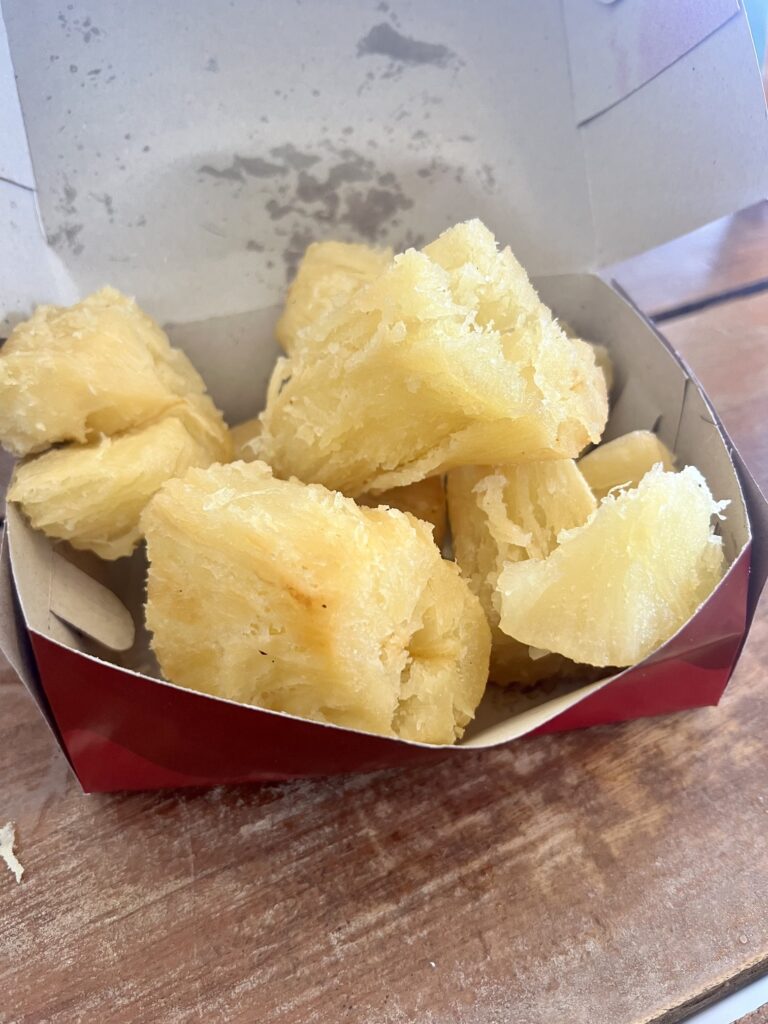
Vegetarian and Vegan Options in Indonesian Cuisine
Indonesian cuisine is famous for its meat dishes and tasty use of shrimp paste. However, there are many choices for vegetarians and vegans to enjoy. Indonesian cooking has always included plant-based ingredients, offering a variety of vegetarian dishes.
Tofu and tempeh are important in Indonesian cooking and are used in many vegetarian and vegan meals. A great example is gado-gado. This colorful vegetable salad comes with peanut sauce and is a delicious vegetarian option.
Tahu and Tempeh Dishes: A Protein-Rich Alternative
Tahu (tofu) and tempeh are key ingredients in Indonesian vegetarian dishes. They come from soybeans and are a great source of protein. These simple foods can be made into tasty meals that highlight the strong flavors of Indonesia.
Tahu has a mild taste. It can soak up other flavors well, which makes it perfect for Indonesian spices. People often deep-fry it until it is crispy, stir-fry it with vegetables, or put it in soups and curries. Tahu goreng (fried tofu) is a favorite street food. It is usually served with spicy peanut sauce.
Tempeh has a firmer texture and a bit of a nutty taste. It adds a nice crunch to meals. It can be sliced, diced, or crumbled and is perfect for stir-fries, salads, and stews.
Vegetable-Based Traditional Dishes
Indonesian food has many tasty vegetarian dishes. These dishes use fresh fruits and vegetables and focus on mixing different flavors. You can find colorful salads, tasty stir-fries, and hearty stews in Indonesian vegetarian cuisine.
One of the main dishes is Gado-gado. This dish is a popular vegetable salad. It includes many blanched vegetables like long beans, bean sprouts, cabbage, and potatoes. It is topped with rich and creamy peanut sauce that makes it even tastier.
Another dish to try is Sayur Lodeh. This is a vegetable stew made with coconut milk. It has a pleasing mix of vegetables like chayote, long beans, and tofu. It gets its flavor from spices like turmeric, galangal, and lemongrass. It’s a comforting choice for any meal.
The Influence of Foreign Cuisines on Indonesian Plates
Indonesian cuisine stands out on its own, but it is also shaped by many foreign cultures that have interacted with the islands over time. The spice trade was key in forming Indonesian flavors. It brought ingredients and cooking styles from faraway places.
The Middle East, India, China, and Europe have all added their unique touches. You can see these influences in the popular dishes that are now a big part of Indonesian cuisine.
Dutch Colonial Legacy in Indonesian Foods
The Dutch colonial period lasted over three hundred years. It changed Indonesian cuisine by adding new ingredients, cooking methods, and food traditions. Some of these changes are small, but others are very clear, affecting how Indonesians eat now.
One important legacy from the Dutch is Rijsttafel. This means “rice table” in Dutch and is a big meal that started during colonial times. Rijsttafel features many different Indonesian dishes served with rice and often includes Dutch-inspired sides.
The Dutch also brought in new ingredients like potatoes, carrots, and bread. These have become part of Indonesian dishes. Rijsttafel is now mostly enjoyed on special occasions, but you can still see its impact in how Indonesians present many side dishes with rice.
Chinese Contributions to Indonesian Dishes
Chinese food has a big impact on Indonesian cooking. This shows how cultures have blended together over many years. Chinese immigrants have left a lasting mark in Indonesia. You’ll find popular dishes like noodles, stir-fries, and tasty snacks that have become part of Indonesian kitchens.
Noodle dishes are very important in both Chinese and Indonesian foods. Mie Goreng, Indonesia’s special fried noodles, looks a lot like Chinese Chow Mein. This shows how they share a cooking history.
Another dish that shows Chinese influence is Lumpia, or Indonesian spring rolls. These tasty snacks are filled with different ingredients like vegetables, meat, and seafood. They are fried until crispy and are usually served with a dip.
Indian Spices and Cooking Techniques
The strong smell of spices and wonderful tastes of Indian food have made a lasting impact on Indonesian cooking. This shows how cultures exchanged ideas over many years. Indian traders brought spices, cooking styles, and food ideas that blended well into Indonesian meals.
Spices like cumin, coriander, turmeric, and ginger, which are key in Indian cooking, are also common in Indonesian food. These spices are the base for many Indonesian spice pastes. They add amazing flavor to curries, stews, and marinades.
Curries, which are important in Indian dishes, are now enjoyed in Indonesia too. However, Indonesian curries often use coconut milk, lemongrass, and other local ingredients. This makes their flavors unique.
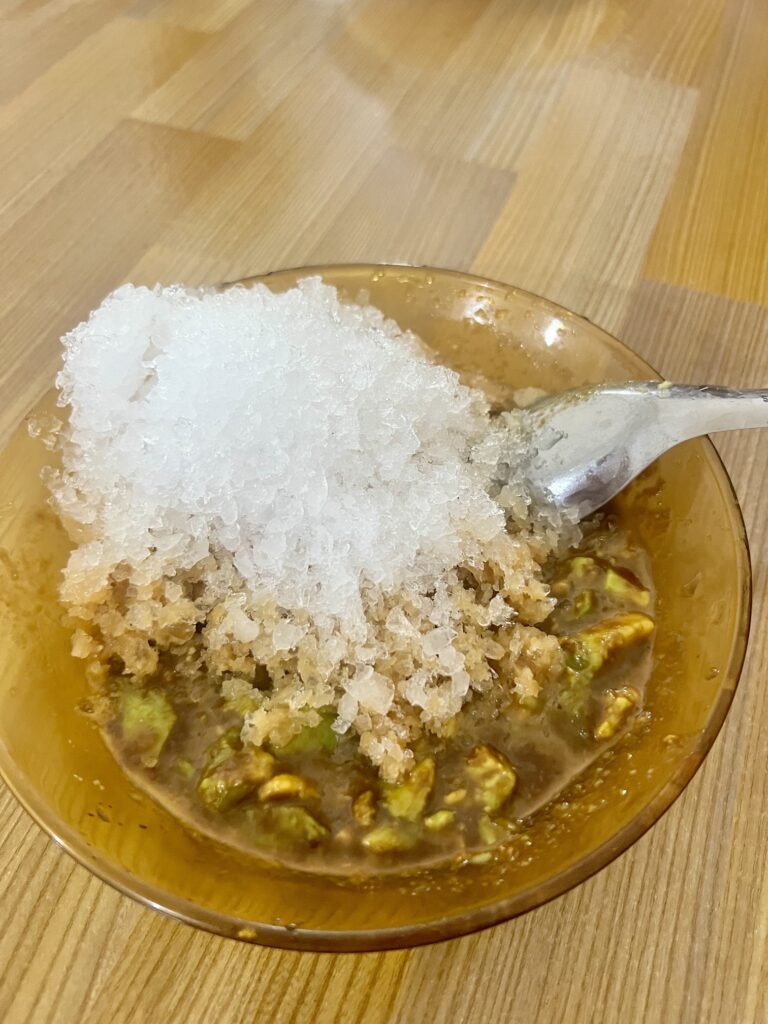
Celebratory Foods and Festive Dishes
Indonesian cuisine is very special during holidays and celebrations. People prepare unique dishes for important events, bringing families and communities together. These festive foods often have special meanings and are an important part of Indonesian culture.
For religious holidays like Ramadan and Eid al-Fitr, families come together to break their fasts with special foods. Dishes like Ketupat, which are diamond-shaped rice cakes cooked in woven coconut leaves, and Rendang, a tasty and rich meat dish, are common. Rendang shows patience and hard work.
Lebaran Specialties: Ketupat and Rendang
The holy month is a special time for many people. It is a time for reflection, prayer, and community. People often focus on their beliefs and values. They may spend time with family and friends. This month is also about giving to those in need. Many engage in acts of charity and kindness during this time. It is a chance to grow spiritually and strengthen bonds with others.
Traditional Balinese Ceremonial Foods
Balinese ceremonial foods are important in Indonesia’s rich cooking traditions. These special dishes are key in many rituals and celebrations. They show the deep cultural meanings of the Balinese people. During ceremonies and special days, well-known dishes like Babi Guling (Balinese roast pork) and Ayam Betutu (Balinese roasted chicken) are the stars of the show. They impress both locals and visitors with their delightful flavors and meanings. These ceremonial foods highlight the unique art and taste of Balinese cuisine. They also remind us of the culture that has been kept alive through many years.
Indonesian Desserts and Sweet Treats
Indulge in the tasty world of Indonesian desserts and sweets. You will love the famous klepon, which are sweet rice cake balls covered in coconut. You can’t miss the yummy dadar gulung, a green pancake filled with fragrant coconut. Each bite brings a rush of sweetness. To cool down, try cendol, a tasty iced dessert with pandan jelly and coconut milk. These classic treats show off Indonesia’s rich food culture. They mix ingredients like palm sugar, coconut milk, and pandan leaves perfectly. Enjoy a taste of paradise with these delightful sweets!
Klepon (Sweet Rice Cake Balls)
Klepon are sweet rice cake balls that you must try in Indonesia. These green snacks are made with pandan leaves and have a filling of palm sugar. Every bite gives you a sweet burst. The chewy outer layer comes from glutinous rice. It contrasts nicely with the liquid palm sugar inside. After they are cooked, they are rolled in grated coconut, which adds a fresh taste. Klepon is a popular traditional snack in Indonesia. People enjoy it for its special mix of flavors and textures. Taste these sweet treats to enjoy real Indonesian desserts.
Dadar Gulung (Green Pancakes with Coconut)
Dadar gulung is a tasty Indonesian dessert. It has green pancakes filled with yummy coconut. The pancakes get their color from pandan leaves. They look great and taste good too. The filling is made with coconut milk and palm sugar. This adds a nice sweetness to the mix. The pancakes are a bit savory, which contrasts well with the sweet filling. Dadar gulung is enjoyed all over Indonesia. It shows the rich and varied flavors of Indonesian food. This traditional treat is something everyone should try while exploring Indonesian cuisine. You will love the special mix of flavors in every bite.
Cendol (Iced Sweet Dessert)
A dessert you must try in Indonesia is cendol. It is a delicious iced treat that many people love. This refreshing dessert has green jelly made from rice flour. It is served with coconut milk, palm sugar, and shaved ice. This mix makes a tasty and fun dessert. The green color comes from pandan leaf extract. The sweet and creamy coconut milk makes it even better. Cendol is perfect for cooling off in Indonesia’s warm weather. Both locals and visitors enjoy this traditional sweet treat.

Indonesian Beverages: Traditional Drinks to Try
Enjoy the lively world of drinks from Indonesia. These traditional beverages show the rich culture of the country. Try jamu, a herbal drink that is famous for being healthy. Warm up with bajigur and bandrek. These are comforting drinks, great for cold nights. Each drink takes you into Indonesia’s food history. They mix local ingredients with old recipes to give you a unique taste. Dive into Indonesia’s true flavors by enjoying these classic drinks.
Jamu: Indonesia’s Traditional Herbal Medicine Drink
Jamu is a traditional herbal drink from Indonesia. It has a long history and is very important to the culture. Made from natural ingredients like turmeric, ginger, and tamarind, jamu is tasty and known for being good for health. Many people believe it helps boost immunity and aids in digestion. Jamu shows how food and wellness are connected in Indonesia. Trying jamu while exploring Indonesian food gives you a nice look at traditional remedies. It highlights the country’s rich healing practices. Enjoying jamu lets you taste Indonesia’s ancient knowledge and lively food culture.
Bajigur and Bandrek: The Warm Comforting Beverages
Experience the warm joy of Bajigur and Bandrek. These are two classic drinks from Indonesia that are perfect for cozy times. Bajigur is made from coconut milk, palm sugar, and ginger. It wraps you in a comforting hug. Bandrek includes ginger, lemongrass, and cinnamon. It warms you from the inside. These drinks show the rich food culture of Indonesia and let you taste a piece of its heritage. They are great for cold evenings or for a boost during the day. Bajigur and Bandrek are special drinks that share warmth and tradition in every sip.
Dining Etiquette in Indonesia: Do’s and Don’ts
In Indonesian dining culture, it is normal to eat with your hands. However, using your left hand is not polite. Indonesian cuisine has many delicious dishes to enjoy. When you eat, do not use your cutlery to point at others, as this is seen as disrespectful. Always use your right hand when trying food, as it shows respect for local customs. It is also polite to wait for the oldest person or the host to start eating before you begin. Following these dining rules can make your experience with Indonesian cuisine even better.
The Use of Hands in Eating: When and How
In Indonesian dining culture, people often eat with their hands, especially with certain dishes. It’s fine to enjoy traditional Indonesian cuisine this way, but there are some rules to remember. First, wash your hands well before and after your meal. You should use your right hand to eat, as the left hand is seen as unclean. To eat, tear a small piece of food with your fingertips. Then, make it into a ball with your thumb. Finally, gently push the food into your mouth with your thumb. Eating with your hands is not just about the way you eat, but also about showing respect for traditions and customs.
Understanding Halal: Dietary Restrictions and Observances
Indonesian cuisine is strongly influenced by Islamic culture, especially in various parts of Indonesia. It usually follows halal dietary rules. These rules tell Muslims what foods they can eat and how to prepare them. Foods like pork and alcohol are not allowed. Instead, people can enjoy halal-certified meat, seafood, and plant-based foods. Restaurants or food stalls that show “Halal” signs follow these rules. Knowing about halal principles helps people have respectful dining experiences in Indonesia. It also helps everyone appreciate different cultures and shows care for various cooking practices. Following halal guidelines makes meals better and promotes cultural exchange, making dining in Indonesia more special and welcoming.
Where to Find Authentic Indonesian Cuisine in Indonesia
For a real taste of Indonesia, go to local warungs where you can find traditional flavors. Check out the busy food markets and enjoy the lively street food scene. This is a great way to experience the region’s food. Visit recommended restaurants to see the best dishes that represent Indonesian cuisine. You can try tasty meals like nasi goreng and aromatic rendang. These places show the wide range of flavors in Indonesian cooking. Dive into the local food culture by tasting dishes at these authentic spots. You’ll have a meal you won’t forget.
Recommendations for Local Warungs and Restaurants
For a real taste of Indonesia, you should try local warungs and restaurants. They give you a genuine look at Indonesian flavors and traditions. Check out warungs that serve classic meals like nasi goreng, sate ayam, and rendang. Make sure to enjoy local dishes at traditional Indonesian restaurants, where the rich food from the islands comes alive. From street stalls to small family-run places, local warungs and restaurants are great for experiencing the lively food culture of Indonesia.
Food Markets and Street Food Tours for the Ultimate Experience
Explore the exciting world of Indonesian food by visiting food markets and taking street food tours. Walk through busy markets filled with bright colors and tasty smells. Try many local dishes, like savory nasi goreng and spicy rendang, all made by skilled street vendors. Enjoy the mix of flavors as you taste gado-gado with its great peanut sauce or enjoy a warm bowl of bakso meatball soup. Discover the heart of Indonesian cuisine in these lively food spots that offer a wide variety of delicious tastes.

Cooking Indonesian Cuisine at Home: Tips and Tricks
To learn how to cook real Indonesian food at home, here are some important tips. First, get key ingredients like palm sugar, coconut milk, and shrimp paste. You should also try using seasonings like sweet soy sauce and chili sauce to get that unique Indonesian taste. When making dishes like nasi goreng or mie goreng, use coconut oil to add an authentic flavor. Don’t forget to look for traditional recipes online and think about joining a cooking class to improve your skills. Enjoy the different flavors of Indonesia in your own kitchen!
Essential Ingredients to Have in Your Pantry
Palm sugar, coconut milk, and soy sauce are must-haves in Indonesian cuisine. They add sweetness and depth to many dishes. Shrimp paste is important too. It boosts umami flavors in traditional recipes. Kecap manis, or sweet soy sauce, is a common condiment that gives a unique Indonesian flavor. Ingredients like tamarind, lime juice, and chili sauce add tang and heat to different meals. Coconut oil is great for cooking and frying. Aromatic spices like coriander, cumin, and turmeric are also key in Indonesian cooking. They make every dish rich with their special flavors.
Simple Indonesian Recipes to Start With
Nasi Goreng is a famous fried rice dish from Indonesia that everyone should try, much like the popular pisang goreng. Start by frying cooked rice. Use soy sauce and kecap manis for flavor, and add shrimp, chicken, or vegetables. Another easy dish is Gado-Gado. It’s a vegetable salad with peanut sauce on top. Just blanch some bean sprouts, spinach, and potatoes. Then, pour the tasty peanut dressing over them. These simple dishes, including pisang goreng, are a great way to explore Indonesian cuisine.
Health Benefits of Indonesian Diet
Indonesian cuisine is tasty and good for your health. It focuses on fresh ingredients like coconut milk, lime juice, and fragrant spices. These dishes are full of important nutrients. Many dishes, like gado-gado and nasi uduk, use lots of vegetables. These provide vitamins and minerals that are key for good health. Also, traditional Indonesian cooking often uses grilling or steaming. This keeps the food healthy and its nutrients intact. Adding the rich flavors of Indonesian cuisine to your meals can be both delicious and nutritious.
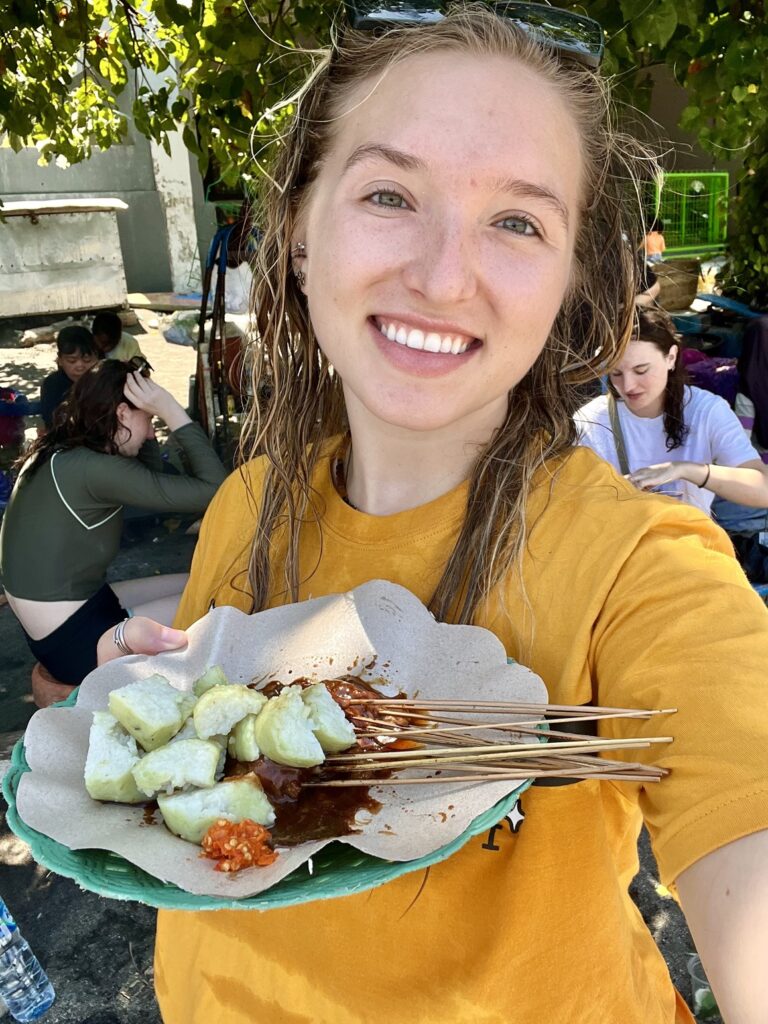
Conclusion
Indonesian cuisine is full of exciting flavors that show the rich cooking traditions of the area. You can enjoy tasty rendang or the sweet klepon. Each dish shares a story from Indonesia’s diverse culture. Whether you are enjoying street food or trying traditional desserts, it is a food adventure unlike any other. So, the next time you go to Indonesia, make sure to dive into the wonderful world of Indonesian cuisine. Let every bite take you to the lively markets and small warungs that show what makes this food paradise special.
Planning a visit to Indonesia? Check out my complete travel guide!
Authentic Indonesian Food- Frequently Asked Questions
What Makes Indonesian Cuisine Unique?
Indonesian cuisine is known for its bright flavors. This comes from spices such as turmeric, lemongrass, and galangal. Dishes like nasi goreng and rendang mix sweet, savory, and spicy tastes. These meals show the rich cooking traditions of Indonesia.
Are There Vegetarian Options in Indonesian Cuisine?
Yes, Indonesian cuisine has many vegetarian choices. You can try Gado-Gado, which is a vegetable salad with peanut sauce. Another option is Sayur Lodeh, a vegetable curry. These dishes highlight the tasty flavors of Indonesia and are good for those who prefer vegetarian food.
What Are Some Must-Try Indonesian Desserts?
Indulge in some essential Indonesian desserts like klepon, dadar gulung, and cendol. These sweet treats give you a fun taste of Indonesia’s rich food history.
How Can I Recreate Authentic Indonesian Flavors at Home?
By getting important Indonesian ingredients like kecap manis and shrimp paste, you can follow traditional recipes for nasi goreng and rendang. When you learn to balance sweet, savory, and spicy flavors, you can make real Indonesian dishes at home.
What is the Famous Food of Bali?
Bali is well-known for its delicious food. Some favorites are babi guling, which is a roast pork, and ayam betutu, a roasted chicken. There are also traditional foods made for ceremonies. These dishes highlight Bali’s rich cooking traditions. They attract visitors with their special flavors and cultural meaning.
What is the Most Popular Street Food in Indonesia?
Nasi goreng, which is fried rice from Indonesia, is the most popular street food there. People love its tasty mix of rice, vegetables, and spices. Both locals and tourists enjoy it a lot.
What is Indonesia’s Signature Food?
Indonesia has some famous foods like nasi goreng, sate ayam, rendang, and gado-gado. These dishes show the variety of tastes in the region. If you love food, you have to try these when you visit Indonesia, as highlighted by the Ministry of Tourism. Enjoy the rich food culture with these true Indonesian treats.
Related Posts
Explore Yosemite National Park: A Nature Lover’s Paradise
Key Highlights Next, let’s dive into what makes Yosemite National Park an unmatched treasure of the United…
Local Favorites: What Food to Eat in California
Key Highlights Introduction California, also called the golden state, is a great place for people who love…
Discover the 20 Best Places to Visit in California Now
Key Highlights Introduction California is a place that has something for everyone. You can find natural beauty…




